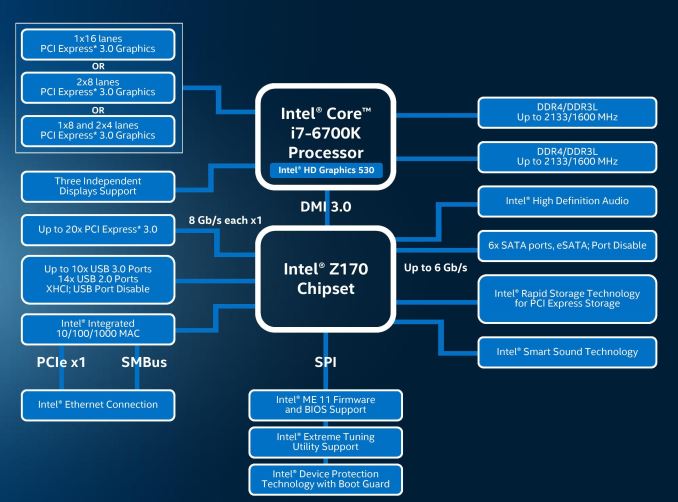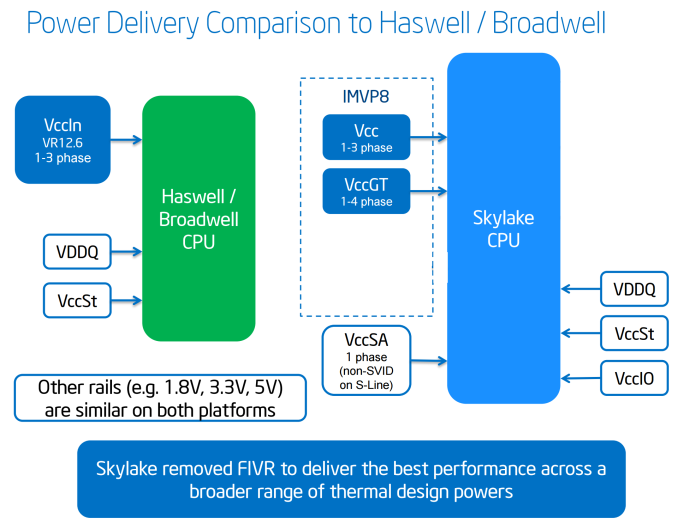The Intel 6th Gen Skylake Review: Core i7-6700K and i5-6600K Tested
by Ian Cutress on August 5, 2015 8:00 AM ESTThe Skylake CPU Architecture
As with any new Intel architecture, the devil is in the details. Previously at AnandTech we have been able to provide deep dives into what exactly is going on in the belly of the beast, although the launch of Skylake has posed a fair share of problems.
Nominally we rely on a certain amount of openness from the processor/SoC manufacturer in providing low level details that we can verify and/or explain. In the past, this information has typically been provided in advance of the launch by way of several meetings/consultations with discussions talking to the engineers. There are some things we can probe, but others are like a black box. The black box nature of some elements, such as Qualcomm’s Adreno graphics, means that it will remain a mystery until Pandora’s box is opened.
In the lead up to the launch of Intel’s Skylake platform, architecture details have been both thin on the ground and thin in the air, even when it comes down to fundamental details about the EU counts of the integrated graphics, or explanations regarding the change in processor naming scheme. In almost all circumstances, we’ve been told to wait until Intel’s Developer Forum in mid-August for the main reason that the launch today is not the full stack Skylake launch, which will take place later in the quarter. Both Ryan and I will be at IDF taking fastidious notes and asking questions for everyone, but at this point in time a good portion of our analysis comes from information provided by sources other than Intel, and while we trust it, we can't fully verify it as we normally would.
As a result, the details on the following few pages have been formed through investigation, discussion and collaboration outside the normal channels, and may be updated as more information is discovered or confirmed. Some of this information is mirrored in our other coverage in order to offer a complete picture in each article as well. After IDF we plan to put together a more detailed architecture piece as a fundamental block in analyzing our end results.
The CPU
As bad as it sounds, the best image of the underlying processor architecture is the block diagram:
From a CPU connectivity standpoint, we discussed the DDR3L/DDR4 dual memory controller design on the previous page so we won’t go over it again here. On the PCI-Express Graphics allocation side, the Skylake processors will have sixteen PCIe 3.0 lanes to use for directly attached devices to the processor, similar to Intel's previous generation processors. These can be split into a single PCIe 3.0 x16, x8/x8 or x8/x4/x4 with basic motherboard design. (Note that this is different to early reports of Skylake having 20 PCIe 3.0 lanes for GPUs. It does not.)
With this, SLI will work up to x8/x8. If a motherboard supports x8/x4/x4 and a PCIe card is placed into that bottom slot, SLI will not work because only one GPU will have eight lanes. NVIDIA requires a minimum of PCIe x8 in order to enable SLI. Crossfire has no such limitation, which makes the possible configurations interesting. Below we discuss that the chipset has 20 (!) PCIe 3.0 lanes to use in five sets of four lanes, and these could be used for graphics cards as well. That means a motherboard can support x8/x8 from the CPU and PCIe 3.0 x4 from the chipset and end up with either dual-SLI or tri-CFX enabled when all the slots are populated.
DMI 3.0
The processor is connected to the chipset by the four-lane DMI 3.0 interface. The DMI 3.0 protocol is an upgrade over the previous generation which used DMI 2.0 – this upgrade boosts the speed from 5.0 GT/s (2GB/sec) to 8.0 GT/s (~3.93GB/sec), essentially upgrading DMI from PCIe 2 to PCIe 3, but requires the motherboard traces between the CPU and chipset to be shorter (7 inches rather than 8 inches) in order to maintain signal speed and integrity. This also allows one of the biggest upgrades to the system, chipset connectivity, as shown below in the HSIO section.
CPU Power Arrangements
Moving on to power arrangements, with Skylake the situation changes as compared to Haswell. Prior to Haswell, voltage regulation was performed by the motherboard and the right voltages were then put into the processor. This was deemed inefficient for power consumption, and for the Haswell/Broadwell processors Intel decided to create a fully integrated voltage regulator (FIVR) in order to reduce motherboard cost and reduce power consumption. This had an unintended side-effect – while it was more efficient (good for mobile platforms), it also acted as a source of heat generation inside the CPU with high frequencies. As a result, overclocking was limited by temperatures and the quality of the FIVR led to a large variation in results. For Skylake on the desktop, the voltage regulation is moved back into the hands of the motherboard manufacturers. This should allow for cooler processors depending on how the silicon works, but it will result in slightly more expensive motherboards.
A slight indication of this will be that some motherboards will go back to having a large amount of multiplexed phases on the motherboard, and it will allow some manufacturers to use this as a differentiating point, although the usefulness of such a design is sometimes questionable.












477 Comments
View All Comments
watzupken - Friday, September 4, 2015 - link
To be honest, I feel the recent AMD chips are not so bad. From my opinion it boils down to 2 things,1) They are not able to get software makers to optimize for their chips,
2) Disadvantage in terms of fab, i.e. 28nm vs 20/14nm.
Of course, they also don't have a pocket a deep as Intel to begin with. So any misstep can have a serious setback for them.
i_will_eat_you - Saturday, December 12, 2015 - link
AMD is long dead especially for the desktop market and server market. For their latest highend chips they simply slap bigger and bigger fans/heat sinks on to deal with a higher TDP from a ramped up clock. I'm not even sure if they have a particularly good standing in the "APU" market, low end market, etc. ARM and Intel are doing much better.They only have a slight gain in the GPU market with the push of HBM but even this does not give them a strong lead and they are falling onto Apple like marketing in attempt to boast their sales.
The only reason people might tolerate AMD at the moment is because a lot of tasks will run ok on a CPU that is not the best or not the best value for money.
Until they release a new architecture and a new fabrication process they are becoming completely out of the game. I agree they have no room for error in that.
Synomenon - Monday, August 24, 2015 - link
So it's possible to have the full 16 PCIe 3.0 lanes from the CPU going to the GPU and have 4 PCIe 3.0 lanes from the chipset going to the m.2 drive on a Z170 board?wyssin - Sunday, August 30, 2015 - link
Here's what I'm talking about.In their i7-6700K review article, bit-tech.net compared chips at stock settings AND at a decent overclock. By seeing both of those results, you can see whether an upgrade makes sense for your needs (assuming you are an overclocker).
http://www.bit-tech.net/hardware/2015/08/05/intel-...
oranos - Tuesday, September 15, 2015 - link
Looks like after 5 years, there is still no reason to upgrade a 2500k.sheeple - Thursday, October 15, 2015 - link
I TOTALLY agree with yousheeple - Thursday, October 15, 2015 - link
THIS is funny, I'm using a SUPER OOOOOOLD L5408 Xeon that sips 40 watts and gives the performance of a 4th. gen i3 and runs ALL the latest 2015 games and the L5408 cost me 40 bucks on ebay, HAHAHAHAHAAAAA!!!!sheeple - Thursday, October 15, 2015 - link
My L5408 isn't even overclocked past 2.76 Ghz and runs The Witcher 3 Wild Hunt (game from 2015 on a machine with a cpu and mobo that together cost me 70 bucks used-the cpu was introduced in beginning of 2008) at 30 fps AVERAGE WITH ALL SETTINGS MAXED @ 1080p using a STOCK GTX 950 LOL!!! Whoever buys one of these "Skynet" Cpu's needs to do more research, SERIOUSLY !!!!sheeple - Thursday, October 15, 2015 - link
DON'T BE STUPID SHEEPLE!!! NEW DOES NOT ALWAYS = BETTER!manolaren - Saturday, October 31, 2015 - link
So if Anandtech tests are accurate, between the skylake cpu's, i5 is the way for a gaming pc. Gaming benchmarks are almost identical, but the price is a lot cheaper for the i5. Considering skylake doesn't bring nothing groundbreaking for the genre, then i cant see any other way for gamer's. My only question is if future games will take advantage of more than 4 cores and make i7 cpu's a must.